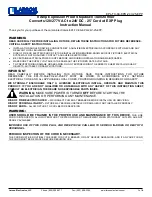
MODEL 5081-A
SECTION 15.0
TROUBLESHOOTING
15.4 OxyGEN MEASUREMENT AND CALIBRATION PROBLEMS
15.4.1 zero current is substantially greater than the value in Section 9.2.
1. Is the sensor properly wired to the transmitter? See Section 3.0.
2. Is the membrane completely covered with zero solution and are air bubbles not trapped against the membrane? Swirl
and tap the sensor to release air bubbles.
3. Is the zero solution fresh and properly made? Zero the sensor in a solution of 5% sodium sulfite in water. Prepare the
solution immediately before use. It has a shelf life of only a few days.
4. If the sensor is being zeroed with nitrogen gas, verify that the nitrogen is oxygen-free and the flow is adequate to pre-
vent back-diffusion of air into the chamber.
5. the major contributor to the zero current is dissolved oxygen in the electrolyte solution inside the sensor. A long zero-
ing period usually means that an air bubble is trapped in the electrolyte. to ensure the 499Ado or 499A trdo sensor
contains no air bubbles, carefully follow the procedure in the sensor manual for filling the sensor. If the electrolyte solu-
tion has just been replaced, allow several hours for the zero current to stabilize. on rare occasions, the sensor may
require as long as overnight to zero.
6. Check the membrane for damage and replace the membrane if necessary
15.4.2 zero reading is unstable.
1. Is the sensor properly wired to the transmitter? See Section 3.0. Verify that all wiring connections are tight.
2. Readings are often erratic when a new or rebuilt sensor is first placed in service. Readings usually stabilize after an
hour.
3. Is the space between the membrane and cathode filled with electrolyte solution and is the flow path between the elec-
trolyte reservoir and the membrane clear? often the flow of electrolyte can be started by simply holding the sensor with
the membrane end pointing down and sharply shaking the sensor a few times as though shaking down a clinical ther-
mometer. If shaking does not work, perform the checks below. Refer to the sensor instruction manuals for additional
information.
For 499Ado and 499A trdo sensors, verify that the holes at the base of the cathode stem are open (use a straightened
paperclip to clear the holes). Also verify that air bubbles are not blocking the holes. Fill the reservoir and establish elec-
trolyte flow to the cathode. Refer to the sensor instruction manual for the detailed procedure.
For Gx438 and Hx438 sensors, the best way to ensure that there is an adequate supply of electrolyte solution is to
simply add fresh electrolyte solution to the sensor. Refer to the sensor instruction manual for details.
Problem
See Section
Zero current is substantially greater than the value in Section 9.2
15.4.1
Zero reading is unstable
15.4.2
Sensor current during air calibration is substantially different from the value in Section 9.3
15.4.3
Process and standard instrument readings during in-process calibration are substantially different
15.4.4
Process readings are erratic
15.4.5
Readings drift
15.4.6
Sensor does not respond to changes in oxygen level
15.4.7
Readings are too low
15.4.8
103
















































